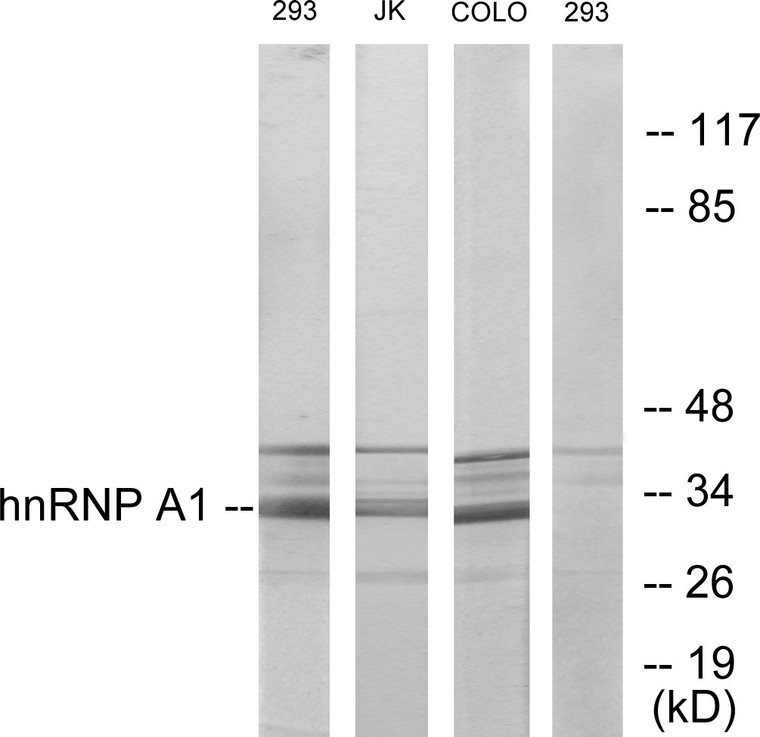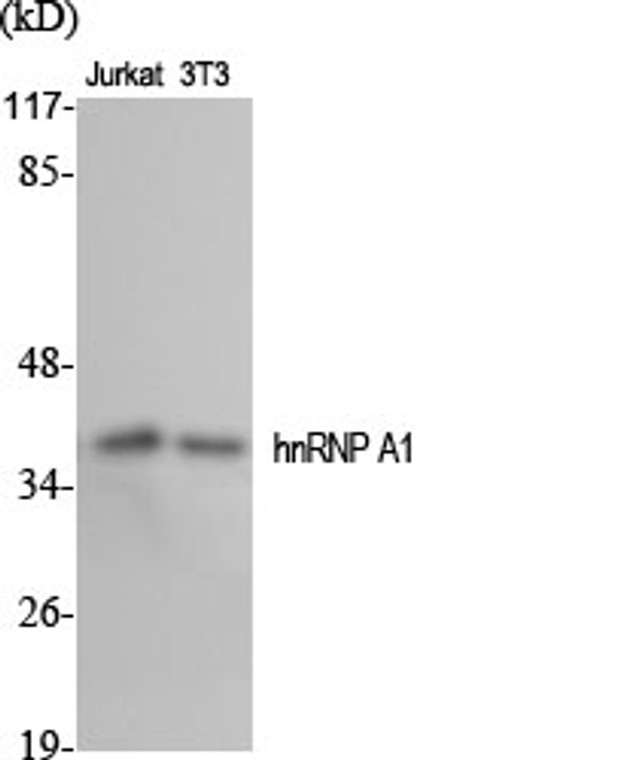| Host: |
Rabbit |
| Applications: |
WB/IHC/IF/ELISA |
| Reactivity: |
Human/Mouse/Rat |
| Note: |
STRICTLY FOR FURTHER SCIENTIFIC RESEARCH USE ONLY (RUO). MUST NOT TO BE USED IN DIAGNOSTIC OR THERAPEUTIC APPLICATIONS. |
| Short Description: |
Rabbit polyclonal antibody anti-Heterogeneous nuclear ribonucleoprotein A1 (51-100 aa) is suitable for use in Western Blot, Immunohistochemistry, Immunofluorescence and ELISA research applications. |
| Clonality: |
Polyclonal |
| Conjugation: |
Unconjugated |
| Isotype: |
IgG |
| Formulation: |
Liquid in PBS containing 50% Glycerol, 0.5% BSA and 0.02% Sodium Azide. |
| Purification: |
The antibody was affinity-purified from rabbit antiserum by affinity-chromatography using epitope-specific immunogen. |
| Concentration: |
1 mg/mL |
| Dilution Range: |
WB 1:500-1:2000IHC 1:100-1:300IF 1:200-1:1000ELISA 1:20000 |
| Storage Instruction: |
Store at-20°C for up to 1 year from the date of receipt, and avoid repeat freeze-thaw cycles. |
| Gene Symbol: |
HNRNPA1 |
| Gene ID: |
3178 |
| Uniprot ID: |
ROA1_HUMAN |
| Immunogen Region: |
51-100 aa |
| Specificity: |
hnRNP A1 Polyclonal Antibody detects endogenous levels of hnRNP A1 protein. |
| Immunogen: |
The antiserum was produced against synthesized peptide derived from the human hnRNP A1 at the amino acid range 51-100 |
| Function | Involved in the packaging of pre-mRNA into hnRNP particles, transport of poly(A) mRNA from the nucleus to the cytoplasm and modulation of splice site selection. Plays a role in the splicing of pyruvate kinase PKM by binding repressively to sequences flanking PKM exon 9, inhibiting exon 9 inclusion and resulting in exon 10 inclusion and production of the PKM M2 isoform. Binds to the IRES and thereby inhibits the translation of the apoptosis protease activating factor APAF1. May bind to specific miRNA hairpins. (Microbial infection) May play a role in HCV RNA replication. (Microbial infection) Cleavage by Enterovirus 71 protease 3C results in increased translation of apoptosis protease activating factor APAF1, leading to apoptosis. |
| Protein Name | Heterogeneous Nuclear Ribonucleoprotein A1Hnrnp A1Helix-Destabilizing ProteinSingle-Strand Rna-Binding ProteinHnrnp Core Protein A1 Cleaved Into - Heterogeneous Nuclear Ribonucleoprotein A1 - N-Terminally Processed |
| Database Links | Reactome: R-HSA-6803529Reactome: R-HSA-72163Reactome: R-HSA-72203Reactome: R-HSA-9692914Reactome: R-HSA-9735869 |
| Cellular Localisation | NucleusCytoplasmLocalized In Cytoplasmic Mrnp Granules Containing Untranslated MrnasShuttles Continuously Between The Nucleus And The Cytoplasm Along With MrnaComponent Of Ribonucleosomes(Microbial Infection) In The Course Of Viral InfectionColocalizes With Hcv Ns5b At Speckles In The Cytoplasm In A Hcv-Replication Dependent Manner(Microbial Infection) Sars Coronavirus-2/Sars-Cov-2 Orf6 Protein Increases Accumulation To The Nucleus |
| Alternative Antibody Names | Anti-Heterogeneous Nuclear Ribonucleoprotein A1 antibodyAnti-Hnrnp A1 antibodyAnti-Helix-Destabilizing Protein antibodyAnti-Single-Strand Rna-Binding Protein antibodyAnti-Hnrnp Core Protein A1 Cleaved Into - Heterogeneous Nuclear Ribonucleoprotein A1 - N-Terminally Processed antibodyAnti-HNRNPA1 antibodyAnti-HNRPA1 antibody |
Information sourced from Uniprot.org
12 months for antibodies. 6 months for ELISA Kits. Please see website T&Cs for further guidance












